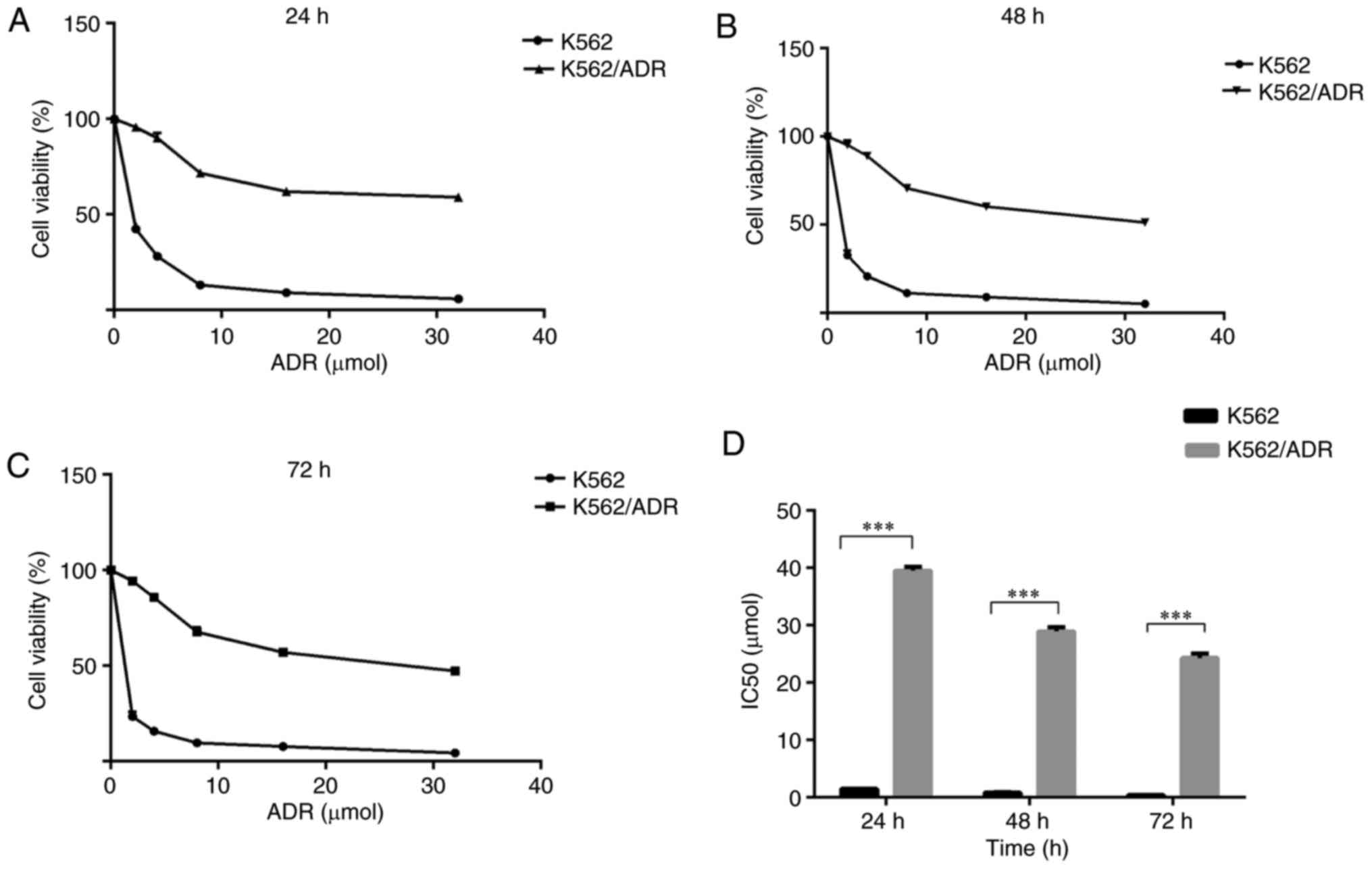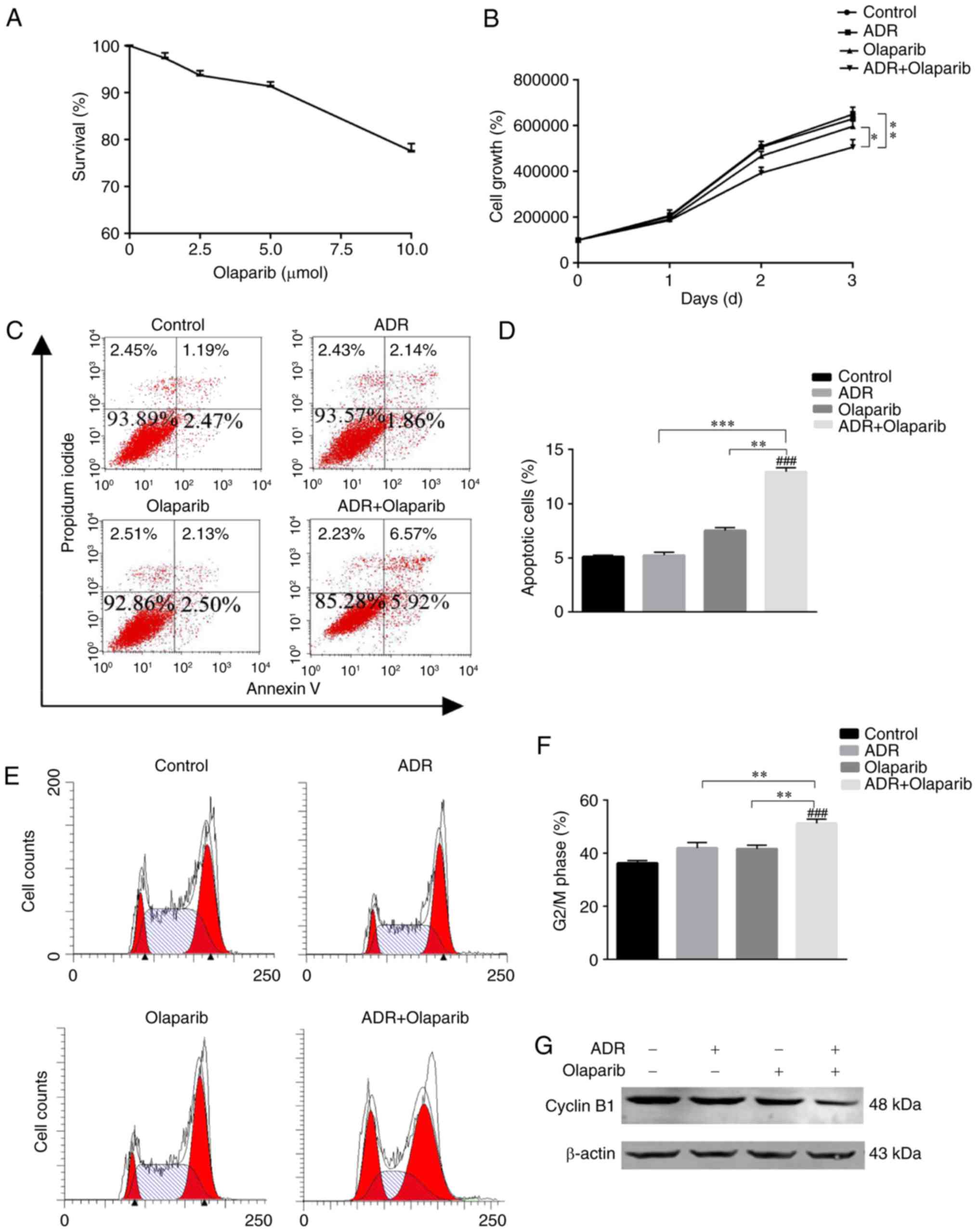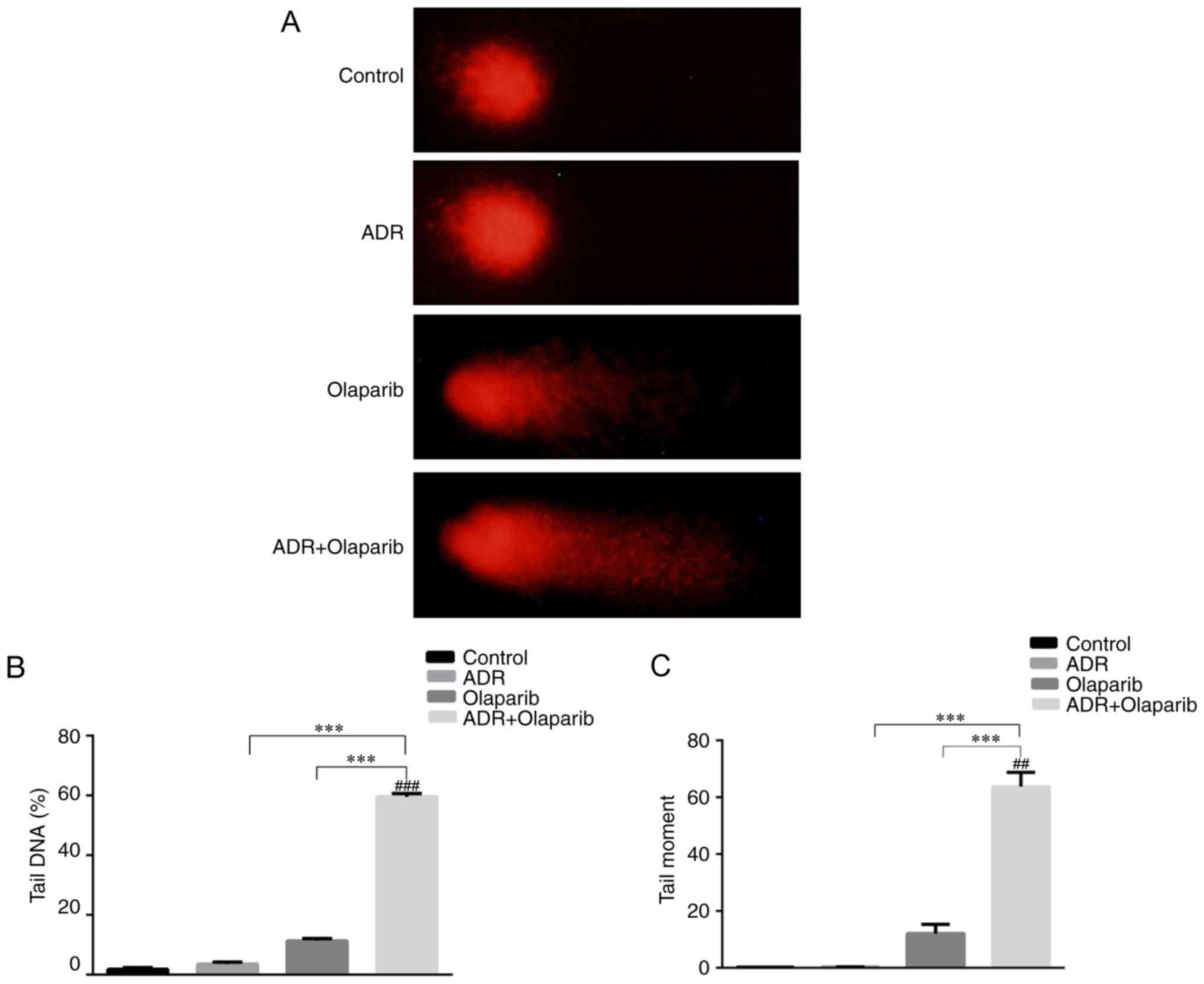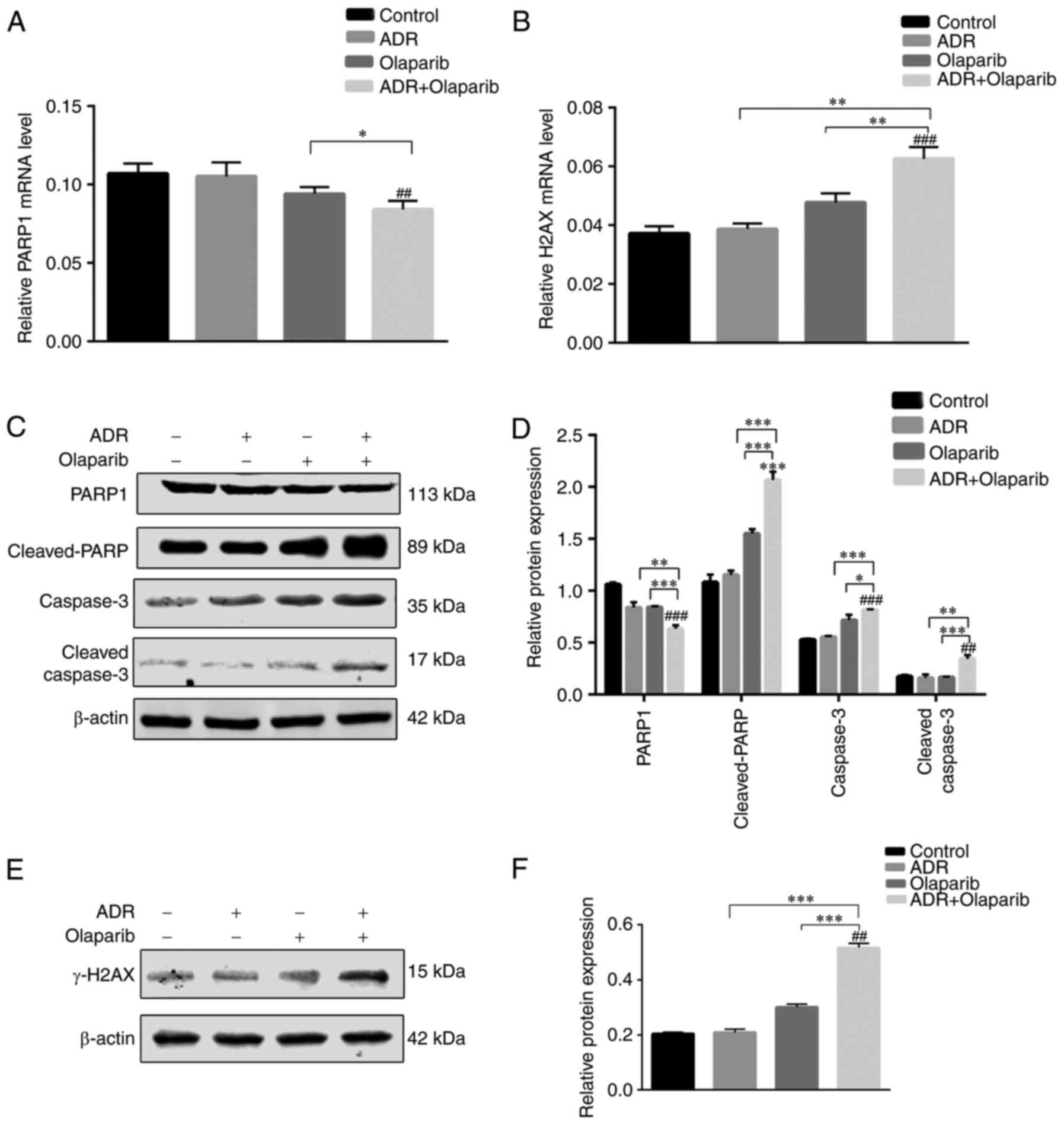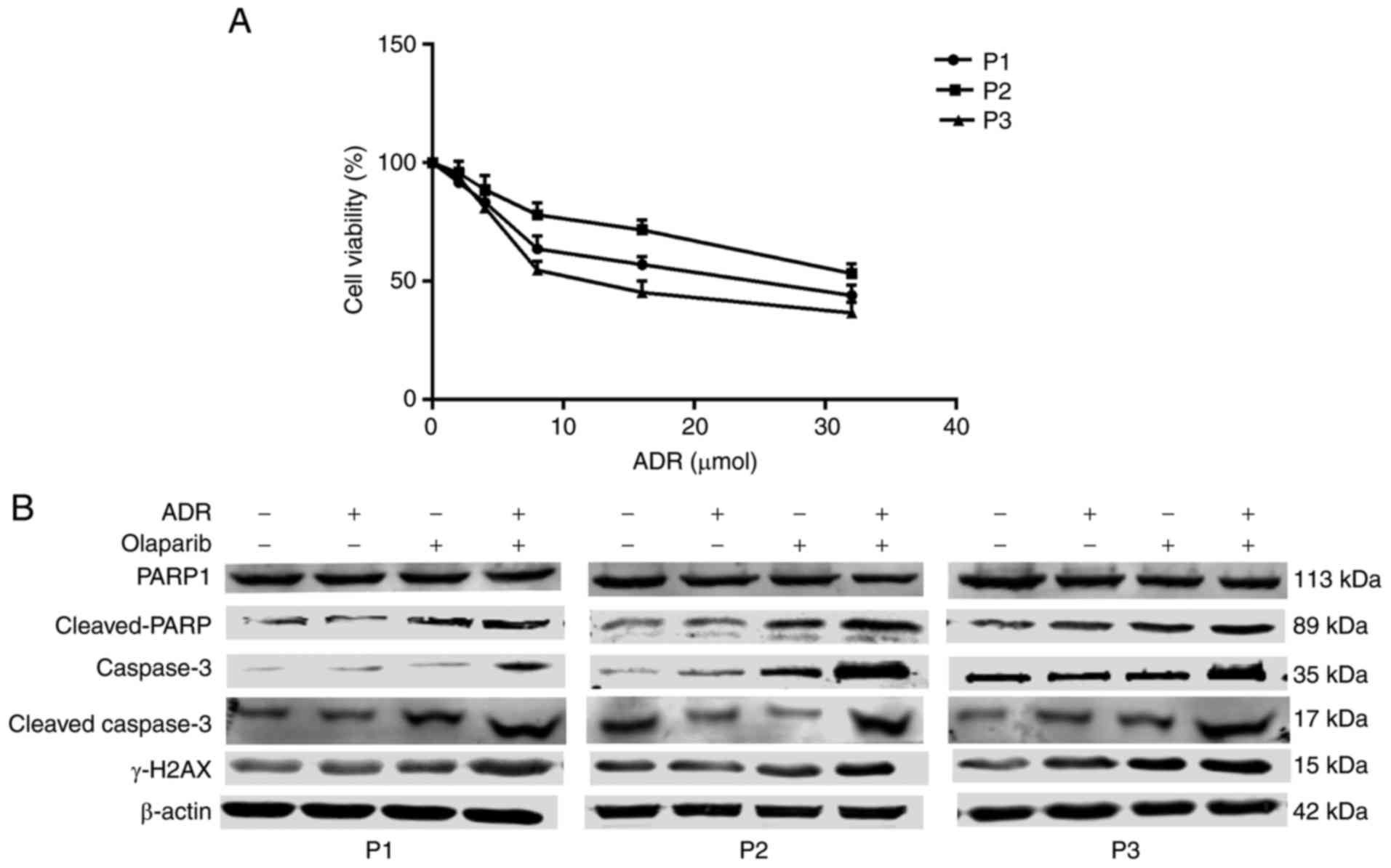|
1
|
Zhang X, Ai Z, Chen J, Yi J, Liu Z, Zhao H
and Wei H: Glycometabolic adaptation mediates the insensitivity of
drug-resistant K562/ADM leukaemia cells to adriamycin via the
AKT-mTOR/c-Myc signalling pathway. Mol Med Rep. 15:1869–1876. 2017.
View Article : Google Scholar : PubMed/NCBI
|
|
2
|
Tabe Y, Konopleva M, Contractor R, Munsell
M, Schober WD, Jin L, Tsutsumi-Ishii Y, Nagaoka I, Igari J and
Andreeff M: Up-regulation of MDR1 and induction of doxorubicin
resistance by histone deacetylase inhibitor depsipeptide (FK228)
and ATRA in acute promyelocytic leukemia cells. Blood.
107:1546–1554. 2006. View Article : Google Scholar : PubMed/NCBI
|
|
3
|
Vinod BS, Maliekal TT and Anto RJ:
Phytochemicals as chemosensitizers: From molecular mechanism to
clinical significance. Antioxid Redox Signal. 18:1307–1348. 2013.
View Article : Google Scholar : PubMed/NCBI
|
|
4
|
Tomicic MT and Kaina B: Topoisomerase
degradation, DSB repair, p53 and IAPs in cancer cell resistance to
camptothecin-like topoisomerase I inhibitors. Biochim Biophys Acta.
1835:11–27. 2013.PubMed/NCBI
|
|
5
|
Wang YQ, Wang PY, Wang YT, Yang GF, Zhang
A and Miao ZH: An Update on Poly(ADP-ribose)polymerase-1 (PARP-1)
Inhibitors: Opportunities and challenges in cancer therapy. J Med
Chem. 59:9575–9598. 2016. View Article : Google Scholar : PubMed/NCBI
|
|
6
|
Neri P, Ren L, Gratton K, Stebner E,
Johnson J, Klimowicz A, Duggan P, Tassone P, Mansoor A, Stewart DA,
et al: Bortezomib-induced ‘BRCAness’ sensitizes multiple myeloma
cells to PARP inhibitors. Blood. 118:6368–6379. 2011. View Article : Google Scholar : PubMed/NCBI
|
|
7
|
Gill SJ, Travers J, Pshenichnaya I, Kogera
FA, Barthorpe S, Mironenko T, Richardson L, Benes CH, Stratton MR,
McDermott U, et al: Combinations of PARP inhibitors with
temozolomide drive PARP1 trapping and apoptosis in ewing's sarcoma.
PloS one. 10:e01409882015. View Article : Google Scholar : PubMed/NCBI
|
|
8
|
Kim G, Ison G, McKee AE, Zhang H, Tang S,
Gwise T, Sridhara R, Lee E, Tzou A, Philip R, et al: FDA approval
summary: Olaparib monotherapy in patients with deleterious germline
BRCA-mutated advanced ovarian cancer treated with three or more
lines of chemotherapy. Clin Cancer Res. 21:4257–4261. 2015.
View Article : Google Scholar : PubMed/NCBI
|
|
9
|
Mateo J, Carreira S, Sandhu S, Miranda S,
Mossop H, Perez-Lopez R, Nava Rodrigues D, Robinson D, Omlin A,
Tunariu N, et al: DNA-repair defects and olaparib in metastatic
prostate cancer. N Engl J Med. 373:1697–1708. 2015. View Article : Google Scholar : PubMed/NCBI
|
|
10
|
Helleday T: PARP inhibitor receives FDA
breakthrough therapy designation in castration resistant prostate
cancer: Beyond germline BRCA mutations. Ann Oncol. 27:755–757.
2016. View Article : Google Scholar : PubMed/NCBI
|
|
11
|
Yao C, Du W, Chen H, Xiao S, Huang L and
Chen FP: Involvement of fanconi anemia genes FANCD2 and FANCF in
the molecular basis of drug resistance in leukemia. Mol Med Rep.
11:4605–4610. 2015. View Article : Google Scholar : PubMed/NCBI
|
|
12
|
Mouw KW and D'Andrea AD: Crosstalk between
the nucleotide excision repair and Fanconi anemia/BRCA pathways.
DNA Repair (Amst). 19:130–134. 2014. View Article : Google Scholar : PubMed/NCBI
|
|
13
|
Xiong T, Wei H, Chen X and Xiao H: PJ34, a
poly(ADP-ribose) polymerase (PARP) inhibitor, reverses
melphalan-resistance and inhibits repair of DNA double-strand
breaks by targeting the FA/BRCA pathway in multidrug resistant
multiple myeloma cell line RPMI8226/R. Int J Oncol. 46:223–232.
2015. View Article : Google Scholar : PubMed/NCBI
|
|
14
|
D'Andrea AD: Susceptibility pathways in
fanconi's anemia and breast cancer. N Engl J Med. 362:1909–1919.
2010. View Article : Google Scholar : PubMed/NCBI
|
|
15
|
McCabe N, Turner NC, Lord CJ, Kluzek K,
Bialkowska A, Swift S, Giavara S, O'Connor MJ, Tutt AN, Zdzienicka
MZ, et al: Deficiency in the repair of DNA damage by homologous
recombination and sensitivity to poly(ADP-ribose) polymerase
inhibition. Cancer Res. 66:8109–8115. 2006. View Article : Google Scholar : PubMed/NCBI
|
|
16
|
Pacher P, Liaudet L, Bai P, Virag L,
Mabley JG, Haskó G and Szabó C: Activation of poly(ADP-ribose)
polymerase contributes to development of doxorubicin-induced heart
failure. J Pharmacol Exp Ther. 300:862–867. 2002. View Article : Google Scholar : PubMed/NCBI
|
|
17
|
Livak KJ and Schmittgen TD: Analysis of
relative gene expression data using real-time quantitative PCR and
the 2(-Delta Delta C(T)) method. Methods. 25:402–408. 2001.
View Article : Google Scholar : PubMed/NCBI
|
|
18
|
Xia B, Tian C, Guo S, Zhang L, Zhao D, Qu
F, Zhao W, Wang Y, Wu X, Da W, et al: c-Myc plays part in drug
resistance mediated by bone marrow stromal cells in acute myeloid
leukemia. Leuk Res. 39:92–99. 2015. View Article : Google Scholar : PubMed/NCBI
|
|
19
|
Tang L, Zhang Y, Pan H, Luo Q, Zhu XM,
Dong MY, Leung PC, Sheng JZ and Huang HF: Involvement of cyclin B1
in progesterone-mediated cell growth inhibition, G2/M cell cycle
arrest, and apoptosis in human endometrial cell. Reprod Biol
Endocrinol. 7:1442009. View Article : Google Scholar : PubMed/NCBI
|
|
20
|
Menear KA, Adcock C, Boulter R, Cockcroft
XL, Copsey L, Cranston A, Dillon KJ, Drzewiecki J, Garman S, Gomez
S, et al:
4-[3-(4-cyclopropanecarbonylpiperazine-1-carbonyl)-4-fluoroben
zyl]-2H-phthalazin-1-one: A novel bioavailable inhibitor of
poly(ADP-ribose) polymerase-1. J Med Chem. 51:6581–6591. 2008.
View Article : Google Scholar : PubMed/NCBI
|
|
21
|
Yao C, Du W, Chen H, Xiao S, Huang L and
Chen F: The Fanconi anemia/BRCA pathway is involved in DNA
interstrand cross-link repair of adriamycin-resistant leukemia
cells. Leuk Lymphoma. 56:755–762. 2015. View Article : Google Scholar : PubMed/NCBI
|
|
22
|
Chen P, Li J, Jiang HG, Lan T and Chen YC:
Curcumin reverses cisplatin resistance in cisplatin-resistant lung
caner cells by inhibiting FA/BRCA pathway. Tumour Biol.
36:3591–3599. 2015. View Article : Google Scholar : PubMed/NCBI
|
|
23
|
Peremarti J, Ramos F, Marcos R and
Hernandez A: Arsenic exposure disrupts the normal function of the
FA/BRCA repair pathway. Toxicol Sci. 142:93–104. 2014. View Article : Google Scholar : PubMed/NCBI
|
|
24
|
Li GY, Liu JZ, Zhang B, Wang LX, Wang CB
and Chen SG: Cyclosporine diminishes multidrug resistance in
K562/ADM cells and improves complete remission in patients with
acute myeloid leukemia. Biomed Pharmacother. 63:566–570. 2009.
View Article : Google Scholar : PubMed/NCBI
|
|
25
|
Fong PC, Boss DS, Yap TA, Tutt A, Wu P,
Mergui-Roelvink M, Mortimer P, Swaisland H, Lau A, O'Connor MJ, et
al: Inhibition of poly(ADP-ribose) polymerase in tumors from BRCA
mutation carriers. N Engl J Med. 361:123–134. 2009. View Article : Google Scholar : PubMed/NCBI
|
|
26
|
Mariano G, Ricciardi MR, Trisciuoglio D,
Zampieri M, Ciccarone F, Guastafierro T, Calabrese R, Valentini E,
Tafuri A, Del Bufalo D, et al: PARP inhibitor ABT-888 affects
response of MDA-MB-231 cells to doxorubicin treatment, targeting
snail expression. Oncotarget. 6:15008–15021. 2015. View Article : Google Scholar : PubMed/NCBI
|
|
27
|
Xu K, Chen Z, Cui Y, Qin C, He Y and Song
X: Combined olaparib and oxaliplatin inhibits tumor proliferation
and induces G2/M arrest and gamma-H2AX foci formation in colorectal
cancer. OncoTargets Ther. 8:3047–3054. 2015. View Article : Google Scholar
|
|
28
|
Ujiki MB, Ding XZ, Salabat MR, Bentrem DJ,
Golkar L, Milam B, Talamonti MS, Bell RH Jr, Iwamura T and Adrian
TE: Apigenin inhibits pancreatic cancer cell proliferation through
G2/M cell cycle arrest. Mol Cancer. 5:762006. View Article : Google Scholar : PubMed/NCBI
|
|
29
|
Yadav N, Kumar P, Chhikara A and Chopra M:
Development of 1,3,4-oxadiazole thione based novel anticancer
agents: Design, synthesis and in-vitro studies. Biomed
Pharmacother. 95:721–730. 2017. View Article : Google Scholar : PubMed/NCBI
|
|
30
|
Dong Y, Xiong M, Duan L, Liu Z, Niu T, Luo
Y, Wu X, Xu C and Lu C: H2AX phosphorylation regulated by p38 is
involved in bim expression and apoptosis in chronic myelogenous
leukemia cells induced by imatinib. Apoptosis. 19:1281–1292. 2014.
View Article : Google Scholar : PubMed/NCBI
|
|
31
|
Liu B, Jian Z, Li Q, Li K, Wang Z, Liu L,
Tang L, Yi X, Wang H, Li C and Gao T: Baicalein protects human
melanocytes from H(2)O(2)-induced apoptosis via inhibiting
mitochondria-dependent caspase activation and the p38 MAPK pathway.
Free Radic Biol Med. 53:183–193. 2012. View Article : Google Scholar : PubMed/NCBI
|
|
32
|
D'Amours D, Desnoyers S, D'Silva I and
Poirier GG: Poly(ADP-ribosyl)ation reactions in the regulation of
nuclear functions. Biochem J. 342:249–268. 1999. View Article : Google Scholar : PubMed/NCBI
|
|
33
|
Xu P, Cai X, Zhang W, Li Y, Qiu P, Lu D
and He X: Flavonoids of rosa roxburghii tratt exhibit
radioprotection and anti-apoptosis properties via the
Bcl-2(Ca(2+))/Caspase-3/PARP-1 pathway. Apoptosis. 21:1125–1143.
2016. View Article : Google Scholar : PubMed/NCBI
|
|
34
|
Cohen GM: Caspases: The executioners of
apoptosis. Biochem J. 326:1–16. 1997. View Article : Google Scholar : PubMed/NCBI
|
|
35
|
Nicholson DW and Thornberry NA: Caspases:
Killer proteases. Trends Biochem Sci. 22:299–306. 1997. View Article : Google Scholar : PubMed/NCBI
|
|
36
|
Nicolini F, Burmistrova O, Marrero MT,
Torres F, Hernández C, Quintana J and Estévez F: Induction of G2/M
phase arrest and apoptosis by the flavonoid tamarixetin on human
leukemia cells. Mol Carcinog. 53:939–950. 2014.PubMed/NCBI
|
|
37
|
Uchida K and Miwa M: Poly(ADP-ribose)
polymerase: Structural conservation among different classes of
animals and its implications. Mol Cell Biochem. 138:25–32. 1994.
View Article : Google Scholar : PubMed/NCBI
|















